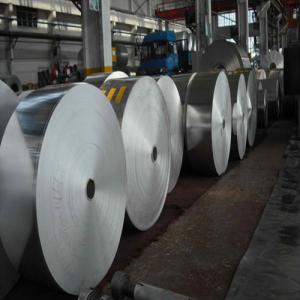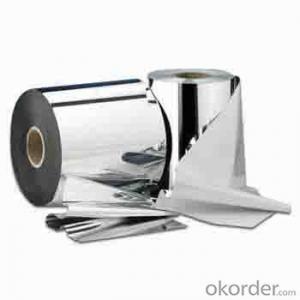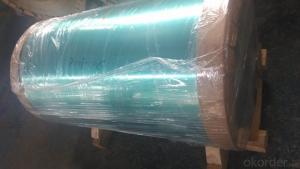Thin Flat Aluminum Strips Cigarette Package Aseptic Package Pouch Sachets in Good Quality
- Loading Port:
- Shanghai
- Payment Terms:
- TT OR LC
- Min Order Qty:
- 1 m.t.
- Supply Capability:
- 1000 m.t./month
OKorder Service Pledge
OKorder Financial Service
You Might Also Like
Specification
1.Specification and Application
LIGHT GAUGE ALUMINUM FOIL
application:cigarette package, aseptic package, pouches, sachets
alloy:1235/8011/8079
temper:O
thickness&tolerance:0.006mm-0.009mm (±6%)
width&tolerance: 200mm-1650mm (±1mm)
mehanical properties: tensile strength (U.T.S)≥40Mpa, elongation≥1%
standard: GB/T3198 / ASTM-B209 /EN 546
3.Other Details
Chemical
Corrosion resistance can be excellent due to a thin surface layer of aluminium oxide that forms when the metal is exposed to air, effectively preventing further oxidation.The strongest aluminium alloys are less corrosion resistant due to galvanic reactions with alloyed copper.This corrosion resistance is also often greatly reduced by aqueous salts, particularly in the presence of dissimilar metals.
In highly acidic solutions aluminium reacts with water to form hydrogen, and in highly alkaline ones to form aluminates— protective passivation under these conditions is negligible. Also, chlorides such as common sodium chloride are well-known sources of corrosion of aluminium and are among the chief reasons that household plumbing is never made from this metal.
However, owing to its resistance to corrosion generally, aluminium is one of the few metals that retain silvery reflectance in finely powdered form, making it an important component of silver-colored paints. Aluminium mirror finish has the highest reflectance of any metal in the 200–400 nm (UV) and the 3,000–10,000 nm (far IR) regions; in the 400–700 nm visible range it is slightly outperformed by tin and silver and in the 700–3000 (near IR) by silver, gold, and copper.
Aluminium is oxidized by water at temperatures below 280°C to produce hydrogen, aluminium hydroxide and heat:2 Al + 6 H2O → 2 Al(OH)3 + 3 H2
This conversion is of interest for the production of hydrogen. Challenges include circumventing the formed oxide layer, which inhibits the reaction and the expenses associated with the storage of energy by regeneration of the Al metal.
4.Packaging and Delivery
| Packaging Details: | packed in wooden box,color box or pp bag or shink. |
| Delivery Detail: | 25-35days |


- Q: Use of aluminium strips for aluminium strips
- 1060 requirements of corrosion resistance and formability are high, but the strength requirements are not high, chemical equipment is its typical use1100 for processing requires good formability and high corrosion resistance but is not required to have high strength parts, such as chemical products, food industry device and storage containers, sheet processing, deep drawing or spinning concave ware, welding parts, heat exchanger, printing plate, nameplate, reflective instruments3004 plates, thick plates, tensile tubes. For as long as extruded tube aluminum cans cans, requires much higher than the 3003 alloy parts, chemical products production and storage device, sheet processing, building baffle, cable conduit, sewer, various lighting components.
- Q: This question asks for a comparison between pure aluminum and aluminum alloy, highlighting their distinct characteristics.
- <p>Aluminum is a lightweight, soft, and ductile metal found in the Earth's crust. It is highly reactive and conducts heat and electricity well. Aluminum alloy, on the other hand, is a mixture of aluminum with other elements such as copper, magnesium, or silicon. These alloys are stronger, more durable, and have improved mechanical properties compared to pure aluminum. They are also less prone to corrosion and can be tailored for specific applications, making them widely used in industries like aerospace, automotive, and construction.</p>
- Q: Is it possible to construct awnings or shelters using aluminum strips?
- <p>Yes, you can use aluminum strips to make awnings or shelters. Aluminum is a popular choice due to its lightweight, corrosion resistance, and strength. It can be bent and shaped easily to create the desired structure. However, it's important to consider the thickness and grade of aluminum to ensure it can withstand the weight and environmental conditions it will be subjected to. Proper support and reinforcement should also be included in the design to maintain stability and durability.</p>
- Q: Is it possible to use aluminum strips to repair a wall that has been damaged by water?
- <p>Yes, aluminum strips can be used to cover a wall damaged by water, but it's not the most effective solution. Aluminum strips are typically used for decorative purposes or as a protective layer in certain applications. For water-damaged walls, it's better to first address the underlying issue, such as fixing leaks or improving drainage. Then, repair the damaged area with appropriate materials like drywall or plaster, followed by painting or other finishing touches. Using aluminum strips without proper repair may lead to further damage or an unsightly appearance.</p>
- Q: Describe the process of manufacturing aluminum strips.
- <p>The production process of aluminum strips involves several key steps. Initially, raw aluminum ingots are melted in a furnace. Once molten, the aluminum is poured into molds to create billets. These billets are then heated and passed through a series of rollers to reduce their thickness and achieve the desired strip dimensions. This process, known as hot or cold rolling, is repeated multiple times to refine the strip's thickness and surface quality. After rolling, the aluminum strips may undergo annealing to improve ductility and strength. Finally, the strips are cleaned, coated if necessary, and cut to length before being packaged and shipped to customers.</p>
- Q: Is it possible to apply paint to aluminum strips once they have been installed?
- <p>Yes, aluminum strips can be painted after installation. However, it is essential to prepare the surface properly. This includes cleaning the aluminum to remove any dirt or grease, then lightly sanding it to create a better surface for the paint to adhere to. It is also recommended to use a primer specifically designed for metal surfaces to enhance the paint's durability and adhesion. After priming, the aluminum strips can be painted with a suitable paint, such as a high-quality acrylic or enamel paint, following the manufacturer's instructions for application and drying times.</p>
- Q: This question asks for a list of various thicknesses that aluminum strips can come in.
- <p>Aluminum strips are available in a variety of thicknesses, which can range from very thin to quite thick depending on the application. Common thicknesses include 0.005 inches (0.127 mm), 0.010 inches (0.254 mm), 0.020 inches (0.508 mm), 0.030 inches (0.762 mm), 0.040 inches (1.016 mm), and 0.060 inches (1.524 mm). Thicker strips can go up to 0.125 inches (3.175 mm) or more. The specific thickness required often depends on the strength and flexibility needed for a particular use, such as construction, automotive, aerospace, or consumer goods.</p>
- Q: This question asks for a comparison of the pros and cons of using aluminum strips as a material for exterior cladding on buildings.
- <p>Aluminum strips for exterior cladding offer several advantages, including their lightweight nature, which reduces structural load. They are also resistant to corrosion, making them suitable for various climates and weather conditions. The ease of installation and maintenance is another benefit, as aluminum is less prone to damage and requires minimal upkeep. Additionally, aluminum strips can be easily recycled, contributing to sustainability efforts. However, there are disadvantages such as the potential for thermal expansion, which can lead to buckling or distortion over time. Aluminum may also dent or scratch more easily than some other materials, and it can conduct heat and cold, potentially leading to energy inefficiency. Lastly, while it is cost-effective in the long run, the initial installation cost can be higher compared to some traditional materials.</p>
- Q: Explain the relationship between aluminum strips and aluminum foil, including their similarities and differences.
- <p>Aluminum strips and aluminum foil are both made from the same material, aluminum, but they differ in their form and thickness. Aluminum strips are typically thin, flat pieces of aluminum that are longer and narrower compared to aluminum foil. They are often used in industrial applications, such as in the manufacturing of electrical components or as a conductive material in various devices. Aluminum foil, on the other hand, is much thinner and is commonly used in cooking, food storage, and packaging due to its high barrier properties against air and moisture. While aluminum strips may be thicker and more rigid, aluminum foil is lightweight and flexible, making it suitable for a wide range of consumer and household uses.</p>
- Q: What are the drawbacks or negative aspects associated with the use of aluminum strips?
- <p>The disadvantages of using aluminum strips include their relatively low strength compared to some other metals, making them less suitable for heavy-duty applications. They can also be prone to corrosion, especially in humid environments, which can reduce their lifespan. Additionally, aluminum strips may not be as rigid as other materials, leading to potential issues with structural integrity. Lastly, while aluminum is recyclable, the recycling process can be energy-intensive, and the environmental impact of its production, including greenhouse gas emissions, should be considered.</p>
Send your message to us
Thin Flat Aluminum Strips Cigarette Package Aseptic Package Pouch Sachets in Good Quality
- Loading Port:
- Shanghai
- Payment Terms:
- TT OR LC
- Min Order Qty:
- 1 m.t.
- Supply Capability:
- 1000 m.t./month
OKorder Service Pledge
OKorder Financial Service
Similar products
Hot products
Hot Searches
Related keywords






















